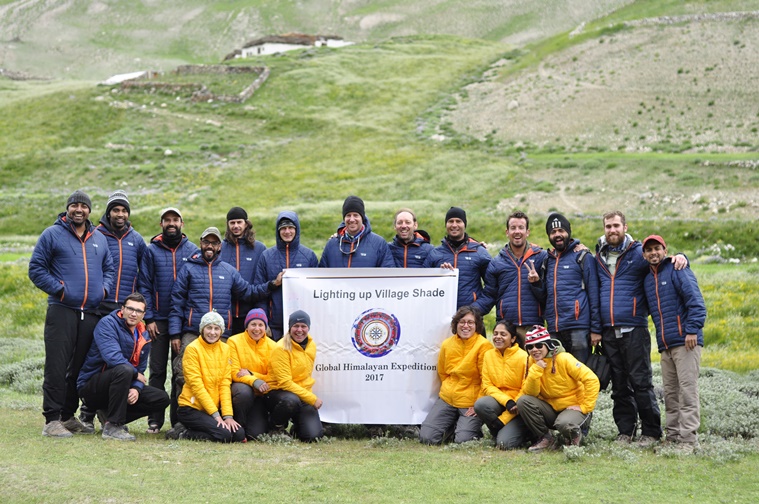- India
- International
How this Himalayan project is taking electricity, sustainability and tourism to remote areas
Social impact enterprise Global Himalayan Expedition (GHE) engages travellers to build resilient communities through sustainable tourism
 Solar lantern distribution at the first village of Sumda Chenmo in Ladakh' s Zanskar in 2013. (Source: GHE)
Solar lantern distribution at the first village of Sumda Chenmo in Ladakh' s Zanskar in 2013. (Source: GHE)An initiative named Global Himalayan Expedition (GHE) has been electrifying remote villages in the Himalayas since 2014. For the formidable task, it recently won the United Nations Framework Convention on Climate Change (UNFCCC) 2020’s United Nations Global Climate Action Awards — the only recipient of the award in India after technology giant Infosys in 2019. The other recipients are companies scattered around the world that are helping combat climate change.
Having electrified more than 130 villages across three regions of India — Leh, Ladakh and Meghalaya — over the past six years, GHE, the brainchild of electrical engineer Paras Loomba, has been providing clean energy access, digital education and livelihood generation in remote communities. “I was working for a US-based electronics company in India and I thought rather than working towards high-tech, we should do something to mitigate climate change. That is when I took a trip to Ladakh. My father, an Army officer, has stayed in the remote areas of India. When I went to Ladakh, I found out I could go an expedition in the Himalayas like Sir Robert Swan does in Antarctica. The difference being, rather than just visiting and coming back, we can do something tangible for the communities in those areas,” Loomba, who undertook an expedition to Antarctica in 2012 led by Sir Swan — the first person to walk to both poles on earth — told indianexpress.com.
“My childhood dream was just to go to Antarctica. But the whole journey was inspirational as I got to meet a lot of interesting personalities who work in varied fields like climate change, technology, academics and so on. The whole journey, as well as the process of fundraising close to 20,000 US dollars and going there, was inspiring,” the 34-year-old shared during a Zoom interaction.
ALSO READ | Climate change set to undo health gains, to affect kids most: Lancet study
Loomba says in the first year, in August 2013, he launched an expedition to Leh. “I had participants from across the globe who were interesting and so inspirational. We had set up a small solar-powered education base for a school with funds from the two-week expedition, which could help students understand experiential education. Here, the children could design robots, do recycling of waste and so on,” he recalled, adding he gradually understood how basic infrastructure like electricity was missing given the geographic remoteness.

“Even though the government tries to stretch the road multiple times to bring electricity, if the road hasn’t come, nothing will come. They had some solar panels but they were using kerosene. They never had grid-based electricity. What grid-based electricity does is that it gives you multiple lights and you can keep adding multiple points like most of the urban dwellers. The solar micro-grids use something called DC — Direct Control technology — which is based on 12 and 24 volts, which is shock-proof,” he described.
How does it work?
GHE conducts ‘impact expeditions’ from across the world to remote Himalayan villages every year and uses a portion of the expedition fee to fund the capital cost of the hardware, transportation, installation and training of village-scale solar micro-grids. The micro-grid infrastructure set up by GHE is owned and operated by the community.
 GHE’s expedition team after lighting up a remotest village in 2017. (Source: GHE)
GHE’s expedition team after lighting up a remotest village in 2017. (Source: GHE)
The cost of the expedition is distributed among the participants. Many participants tend to crowdfund the expedition, in the process, creating awareness about such remote locations, said Loomba.
A few engineers accompany travellers on the expedition, and over the fortnight, the travellers learn about solar power, grid electricity and more, even if they are not engineers. “On the seventh night, they experience total darkness to understand what life is without light, and on the next day, they start working on the micro-grids to experience the solar-powered light.”
What’s the impact?
To date, by solar electrification, the enterprise has directly impacted the lives of more than 60,000 villagers. More than 3,200 households are now CO2-free as kerosene oil has been replaced by solar energy. A total solar capacity of 360 kW has been set up in some of the most remote villages of India. This has cut an aggregate of 35,000 tonnes of CO2 emissions from these communities by eliminating the need for kerosene. To ensure sustainable development of these villages, GHE has created livelihood opportunities in the local indigenous communities through tourism and local handicrafts. Livelihood through homestay tourism has enabled a 45 per cent increase in the annual household income.
“They have been deprived of basic facilities because of geographic remoteness, yet they are fertile grounds for bringing in development and sustainable tourism as people want to explore offbeat destinations. We have created a platform for people to travel responsibly, to visit these remote places and to create a tangible impact on the ground. This also creates a strong bond between the travellers and helps maintain a community ecosystem. We are also working with big corporate houses as they are sending their employees on leadership expeditions. We are working with a couple of universities to reach more youth,” said Jaideep Bansal, who joined the first Impact Expedition in 2013 and later went on to become a volunteer before becoming COO of the enterprise, explained.
ALSO READ | Breaking the myth: Is a sustainable lifestyle really an expensive affair?
“For us, awards are great recognition. It shows it does not matter how big or small the company is. It is about the impact that you are able to create. It reinforces the belief of the kind of impact, the kind of ecosystem created for the communities, for the travellers and our stakeholders,” he said.
Future scope
Travel and tourism were the first to get hit and probably “the last to recover” amid the pandemic. So, how is the team coping?
“We are working beyond electrification, on solar water heaters and greenhouse technology, as food security is a major issue in the mountains. We are trying to see if we can train people on smart agricultural techniques. So the pandemic and subsequent lockdowns helped us think about how we can evolve the model better. We also made contacts outside India as access to energy is not an issue typical to India. We are working in Nepal, identifying areas in Madagascar in South Africa, where similar communities without access to energy exist to launch an expedition so that travellers can fund the whole model. That was the whole idea,” Bansal said. He added that they have developed indigenous technologies like an app called ‘Homestay Travel Information Server’ (HTIS), ‘Destination Monitoring’ and ‘Travel Info Server’, a digital interface to monitor health parameters in remote locations.
“To sum it all, we have lots of innovations going on,” said the 32-year-old mechanical engineer.
For more lifestyle news, follow us: Twitter: lifestyle_ie | Facebook: IE Lifestyle | Instagram: ie_lifestyle
Apr 25: Latest News
- 01
- 02
- 03
- 04
- 05



































